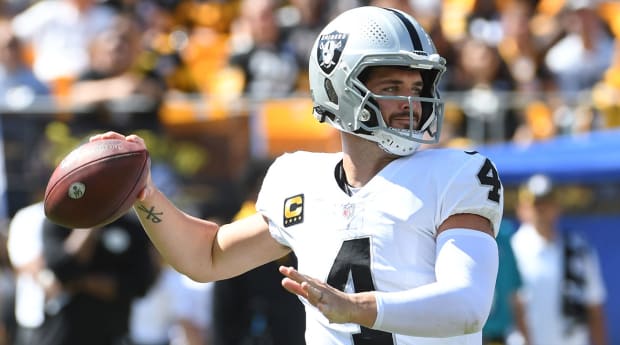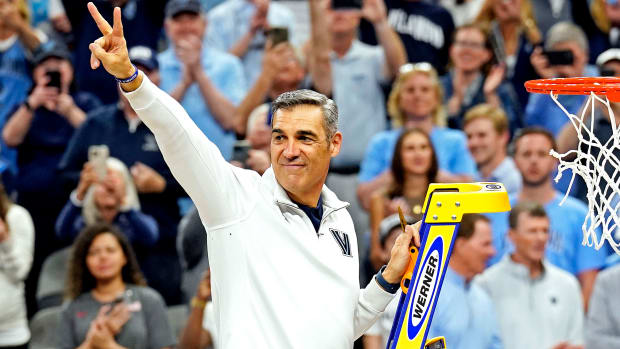View the original article to see embedded media.
It’s draft week, when roughly 250 new NFL players will become cheap and fixed labor for NFL teams for at least three years, with team leverage even after that point, all illustrated in notes below. Draft coverage is not my lane at all, and I try to stay out of it, but for those interested I have written my war room stories and perspectives—including the fateful drafting of Aaron Rodgers—in this space before.
Before the draft, however, there are a few other interesting business of football stories that caught my eye.

Philip G. Pavely/USA TODAY Sports
Carr compliant with Raiders
The quarterback position is not only the most important in the game of football but also the most important in the business of football. And with the game-changing (I think) contract signed by Deshaun Watson a few weeks ago, it just got more interesting. Or, in the case of Derek Carr and the Raiders, maybe not.
As usual, initial media reports blurred the truth about this contract, as headlines blared about a three-year, $121.5 million extension, an average of over $40 million per year. As I often have to do, here is the translation of this extension: one year, $25 million and then “We’ll see.” There is no guaranteed money after this year; zero.
Of course, it is highly unlikely that Carr will be cut after this year, or even after next year, but that is not the point. Contracts are about allocation of risk, and the Raiders have allocated all the risk after 2022 to Carr, rather than vice versa.
I have wondered aloud about the potential impact of the fully funded and fully guaranteed Watson deal (where the Browns—not their quarterback—took on all the risk). I have thought that—despite teams and owners trying to explain it away as an outlier—it would now be precedent for top quarterbacks. And although Carr is not seen as the level of player Watson is, perhaps he could get at least three years fully guaranteed, certainly two. But the Watson precedent seemed to have absolutely no impact here.
The Raiders, as all teams will now try to do, succeeded in removing the Watson contract from the negotiation. It was up to Carr and his agent to fight that narrative, as it will be up to players and agents in the future. But in this first negotiation post-Watson, the team’s quest to label the Watson deal as an aberration was a successful one. Carr submitted to the traditional team-friendly contract structure.
To be fair, Carr did garner an impressive $100 million in cash flow over the first three years of the extension, a number that compares very favorably to the first-three-year cash flow of Josh Allen ($95 million) and zooming past Patrick Mahomes ($63 million). That number holds up well in a still-developing marketplace.
Kyler’s and Deebo’s laments
This time of year is what I call “me time” in the NFL, when players are concerned about their personal situations. We are months away from “we time,” when the teams gather for the grind of training camp and the season.
Kyler Murray’s and Deebo Samuel’s rumbles of discontent have been brewing all offseason. I certainly see their position, at least the financial part of it. But in good part due to the rookie contract system in the CBA, the leverage still lies with the Cardinals and 49ers.
Both players have played the three years required before the CBA allows renegotiation of rookie contracts, yet judging by their Instagram scrubbing of team affiliations, the teams have either decided to wait on negotiations or not to offer market value.
In Murray’s case, the Cardinals have two more years of contract control—this year and the team option in 2023—and potentially franchise tags after that. And Samuel is stuck on a highly undervalued contract in his fourth year, while the wide receiver market has had a transformation.
Murray has been playing on a contract averaging roughly $8 million per year while similarly talented players are making $25 million–30 million per year.
Samuel has been playing on a contract averaging less than $2 million per year while similar players on veteran contracts are making $18 million–25 million per year.
The players have a right to be disgruntled, but the teams have a right to do what they are doing as well. The players’ real issue is not with the teams, but rather with the CBA rookie pay system, one that not only disadvantages starting players early in their career, but has increased penalties for players holding out, to boot.
From a team perspective, when I worked in the front office I cared very little about players missing offseason workouts or even the offseason minicamp. Will the 49ers trade Samuel? Well, I suppose they could if they got the right deal. But if they don’t, I’m not sure how much this will matter in September.
As I often say, the rookie pay system is the gift to NFL teams that keeps on giving.

Scott Wachter/USA TODAY Sports
Jay Wright sees the NIL revolution coming
Finally, a note connected with my day job as a professor at Villanova University Law School, with the retirement of a colleague whom I truly admire.
After the initial shock of hearing basketball coach Jay Wright was retiring, it started to make more sense. I talk with Jay occasionally and help his players on the business side with name, image and likeness, picking an agent, etc. Over the past couple of years, we have talked often about the changing face of college athletics, both prior to NIL and since.
I had my students do their final presentations on NIL this week, and there is no other conclusion than it is truly the Wild West out there. The NCAA threw up its hands on regulating this in late June, cowed by potential antitrust lawsuits (there will always be lawyers). Congress, despite many bills in the hopper, has not acted, and the only oversight is from the schools themselves, which are not going to turn themselves in.
NIL was innocent at first, allowing players to earn some money or merchandise for some Instagram posting, and the average NIL deal is a couple hundred dollars. However, a more sinister element has entered, especially in college football, but certainly in college basketball as well.
Collectives and directives are pools of funds from donors and boosters to, well, recruit and retain the best athletes. Texas A&M “spent” $25 million on this year’s football recruiting class. A high school quarterback from California is going to receive $8 million to play for Tennessee. NIL was never supposed to be a recruiting inducement or “pay-for-play.” But the training wheels have come off; that is exactly what it is becoming. And without oversight or regulation, there is no endpoint in sight. I don’t know if this new NIL world was wearing on him, but Jay sees a new landscape of college sports upon us and it is a good time to transition out, with the program in a good place.
Jay’s mantra to players was always to stay “humble and hungry,” and he embodied that. His humility belied his GQ looks; when he negotiated his contract, there was no big-firm agent, only a local lawyer. As for his stylish suits, he used a local Philadelphia haberdasher; no celebrity stylist for him. Jay took three-star recruits and competed successfully against programs with five-star talent. Simply, there is no better guy or coach than Jay Wright. I look forward to having him around at Villanova; he will continue to be a great asset to us at the school.







